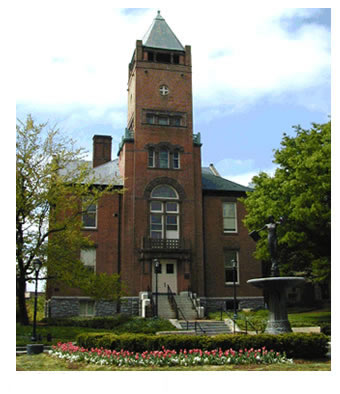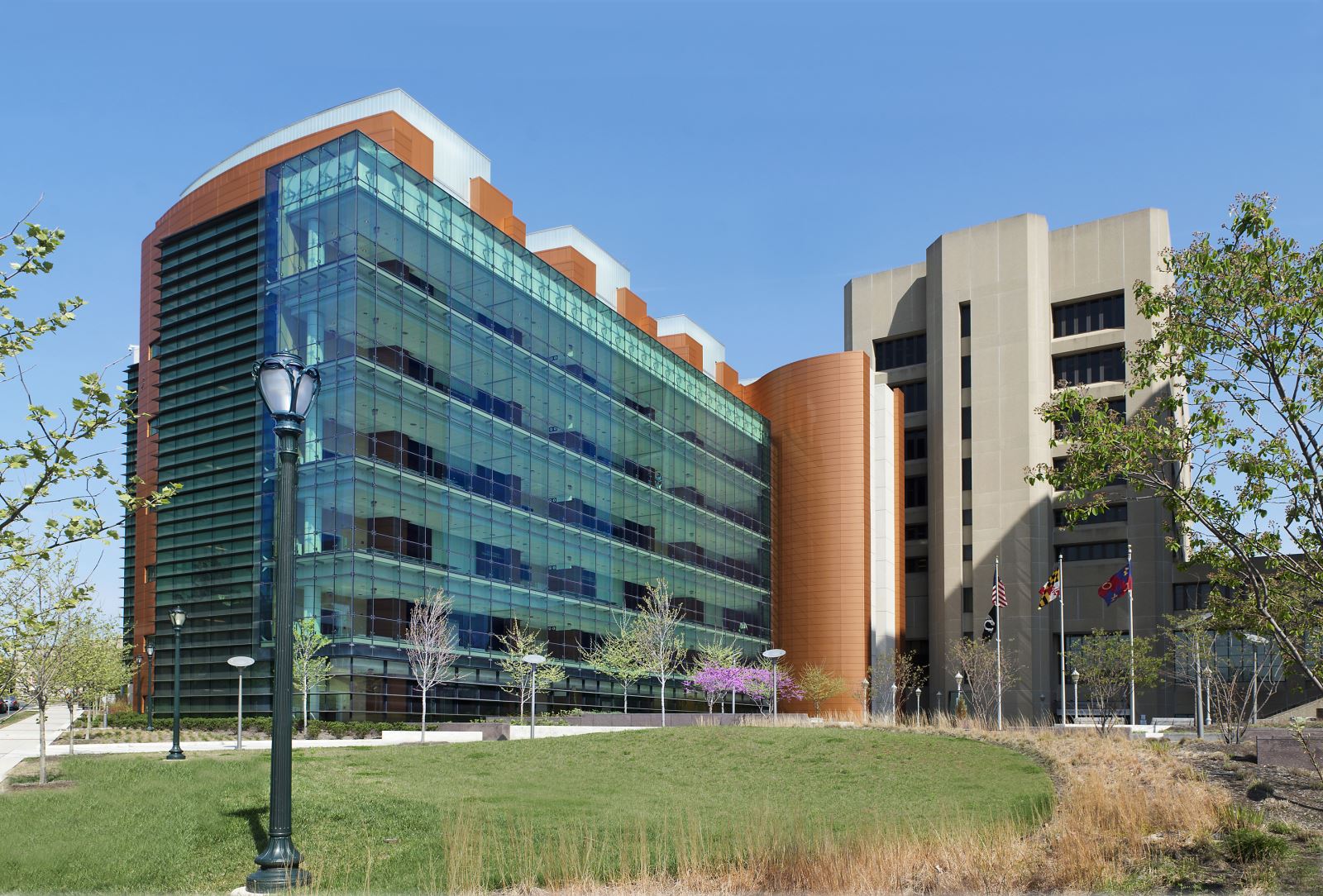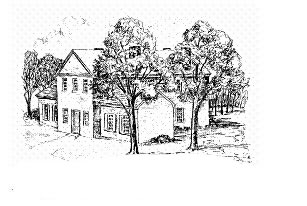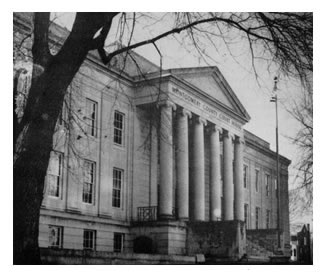By the late 1800's, facing the demand for a new courthouse, the General Assembly granted permission to demolish the old courthouse and the building occupied by the county school commissioners in order to build a new fireproof courthouse that would also accommodate the school commissioners. For this purpose a bond issue of $50,000 was authorized, as well as an expenditure of any proceeds derived from the materials of the two old buildings. The contractor was to be the lowest bidder and was to agree to have the building ready for occupancy by October 1, 1891. This third courthouse in Rockville is still standing and forms an annex to the fourth courthouse. Frank E. Davis was the architect and Thomas P. Johns the contractor. It is a three-story red brick building surmounted by a tower.
The courthouse changed with the times, in use, as well as appearance. In 1899, steam heat replaced the inefficient Smead heating system. Gas lighting was converted to electricity in 1913. By the 1920's, Montgomery County experienced an increase in its population, the issuance of building permits, and new suburban development. Montgomery County’s first police officers were installed in a ceremony at the Red Brick Courthouse, and Rockville's fire engine was parked at the courthouse.
The Red Brick Courthouse housed smaller offices and lesser courts. In the 1960's, the Council allocated funds to demolish the Red Brick Courthouse, but citizens protested. When the Montgomery County Circuit Court opened in 1982, the old courthouse closed with an uncertain future. Peerless Rockville, a nonprofit historic preservation group, worked with Montgomery County to document the history of the courthouse. When the county began renovations in 1990, Peerless formed "Friends of the Red Brick Courthouse" and raised the funds necessary to restore the original courtroom to its 1891 appearance. Work was completed in 1995. The courthouse returned to use with a Circuit Court trial on January 18, 1996. On February 15, 1996, the courtroom was rededicated for its original use.

For most of Montgomery County's history, a single building, familiarly known as "The Courthouse," served all functions of local government. The Red Brick Courthouse is the County's third on this site, constructed in 1891 at a cost of $50,000.
The Red Brick Courthouse reflects the image and aspirations of rural Montgomery County in 1891. Roads were crude, daily trains connected county commuters and farmers with the nation's capital, and trolley tracks were planned between Rockville and Georgetown. The county's 27,185 residents visited the "Richardsonian Romanesque" style courthouse as litigants and jurors, to pay taxes, buy dog tags, probate wills, obtain marriage and business licenses, record deeds, speak to County Commissioners, and request law enforcement from the Sheriff.
The courthouse changed with the times, in use as well as appearance. In 1899, steam heat replaced the inefficient Smead heating system. Gas lighting was converted to electricity in 1913. By the 1920s, Rockville's volunteer firemen responded to a siren in the tower, and our six county police officers met daily on the front steps to exchange information and see citizens.
Local government expanded with the population. The Gray Courthouse opened in 1931, followed by county buildings in Bethesda and Silver Spring. The Red Brick Courthouse housed smaller offices and lesser courts. The grand courtroom was divided for smaller spaces, the vaulted ceiling "dropped" to conserve heat, and the stained glass covered with plywood. In the 1960s, the Council allocated funds to demolish the courthouse, but citizens protested. When the Judicial Center opened in 1982, the old courthouse closed with an uncertain future.
Peerless Rockville, a nonprofit historic preservation group, worked with Montgomery County to document the history of the courthouse. When the county began renovations in 1990, Peerless formed "Friends of the Red Brick Courthouse" to raise funds to restore the grand courtroom to its 1891 appearance. "Friends" held auctions and Victorian Balls, sold posters and dog tag jewelry, and celebrated the Centennial. Private donations and public funds removed the unsympathetic alterations and restored original materials.
Work was completed in 1995. The grand courtroom returned to use with a Circuit Court trial on January 18, 1996.
Furnishings in the Grand Courtroom
...."On the second floor are rooms for the school board and state's attorney, judge's consulting room, apartment for female witnesses and petit jury room. Upon this floor is also the main courtroom - 50 x 60 feet - with vaulted ceiling 24 feet high and lighted by two immense stained glass windows. The judge's bench, clerk's desk, and seats are all ash, finished in hard oil, and present a neat and rich appearance....The entire building presents a fine appearance and is quite an ornament to the town and a credit to the county." Montgomery County Sentinel, October 2, 1891
Trusses
The huge oak trusses and vaulted ceiling accentuate what longtime Rockville attorney Barnet Welsh calls a "cathedral-like atmosphere." The corbel bases are of cast stone, each a slightly different pattern. For many years, these architectural features hid under a dropped ceiling and layers of paint.
Stained Glass Windows
The original windows have been cleaned and repaired. Much of the clear glass is original. A third stained glass window is located in the anteroom.
Orientation of the Courtroom
The Courtroom orientation now is reversed from the original plan. In 1891, citizens reached the second floor via a double stairway at the main (north) entrance of the building. They paused at the landing, passed a stained glass window, and walked through an anteroom before entering the courtroom. Then, the public entered the doorway through which the judge comes in today. Early judges entered the courtroom through a doorway from chambers (where the elevator is now) and walked directly onto the bench at the end of the room. The double stairway was removed in the early 1950s.
Anteroom
Two doors led from this area to the tower, one to a spiral stair, the other to a small elevator that transported records to a fireproof room. In 1995, the decorative plaster cornice was rescued from under a dropped ceiling, repaired, and repainted in original colors. This area is now the judge's chambers.
Niche in the wall behind the Bench
Originally, this opening was probably used to permit courtroom spectators to access stairs to a seating gallery below the plaster arch. In the mid-20th century, this opening permitted judges to pass from their chambers onto the bench, located about where it is now.
Wainscot and Doors
These are recreated in oak, in a pattern based upon wainscoting in the anteroom and first floor. None of the doors is original; the two on the south wall were added after removal of 1950s paneling revealed their locations.
Lights
No records exist of the earlier artificial lighting in the courtroom (presumably kerosene and/or gas), but the County Commissioners decided in 1910 to equip the building with electric lights. These appear in a 1913 photo of a room on the first floor of the courthouse, providing the earliest pictorial evidence available. The chandeliers and sconces in the courtroom and anteroom were recreated with this information.
Judge's Bench
The new bench was recreated from historic records and photographs, and adapted for 1995 needs. Like the original, the wood is ash.
Smead System
The Red Brick Courthouse was designed around this warming and ventilation system. Coal furnaces in the basement heated air, which rose through four chimneys to all parts of the courthouse. Occupants turned valve regulators to admit the amount of heat desired through grilles. Unused heat exited through the cast iron grille in the courtroom ceiling. When the Smead system was abandoned in 1899, some chimneys served as trash pits; "Friends" sold discarded 1917 dog tags to raise funds. In restoring the courthouse, regulators were brought in from other rooms, as were the grilles on the east side; grilles on the west side are reproductions.
Paint Colors
Paint analysis revealed vibrant colors on the four plaster arches in the courtroom, and in the plaster cornice of the anteroom.
Bar and Jury Railing
These have been recreated for the courtroom, based upon photos of the other courthouses of the period. The oak public benches are less ornate than the originals, but were available from court storage.
Interpretive Plaques
The plaques were installed in 1996 to commemorate the courtroom's return to active use, and to indicate the major contributors who made the restoration possible.
Sources of Information
Contemporary descriptions in the Montgomery County Sentinel newspaper; photographs (earliest of courtroom is 1952); recollections; WPA drawings (1939); architectural investigation; paint analysis; Minutesof the County Commissioners. Peerless Rockville has published a Centennial history of the Red Brick Courthouse, and offers an exhibit at the Courthouse Square entrance of the building.
Information regarding the Redbrick Courthouse was provided by Peerless Rockville.
The Red Brick Courthouse was listed in the National Register of Historic Places in 1986, and designated in a City of Rockville Historic District in 1979 (both designations also encompass the 1931 Courthouse). An exterior and partial interioreasement is held by the Maryland Historic Trust.

 There are no records regarding the purchase of this plot of land except documentation indicating that Francis Kidwell, a carpenter, built the courthouse on the purchased land. The courthouse was of sufficient size to accommodate not only the court, but also other officers of the county until 1810 when it became necessary to construct a separate building to house the Clerk of the Court and the court’s records.
There are no records regarding the purchase of this plot of land except documentation indicating that Francis Kidwell, a carpenter, built the courthouse on the purchased land. The courthouse was of sufficient size to accommodate not only the court, but also other officers of the county until 1810 when it became necessary to construct a separate building to house the Clerk of the Court and the court’s records.

 In 1929 a bond issue was authorized for a new building and for the purchase of additional land next to the old courthouse in order to meet the growing demand of the county government, which had again outgrown its available space. With the help of supplementary funds authorized by the General Assembly, the courthouse was built in 1931 at a cost exceeding $500,000. It was designed by Delos H. Smith and Thomas R. Edwards of Washington and built by the J. J. McDevitt Company of Charlotte, North Carolina. It is constructed of Indiana limestone in the classic tradition with the use of columns, cornice and the regular repetition of piers or pilasters.
In 1929 a bond issue was authorized for a new building and for the purchase of additional land next to the old courthouse in order to meet the growing demand of the county government, which had again outgrown its available space. With the help of supplementary funds authorized by the General Assembly, the courthouse was built in 1931 at a cost exceeding $500,000. It was designed by Delos H. Smith and Thomas R. Edwards of Washington and built by the J. J. McDevitt Company of Charlotte, North Carolina. It is constructed of Indiana limestone in the classic tradition with the use of columns, cornice and the regular repetition of piers or pilasters.